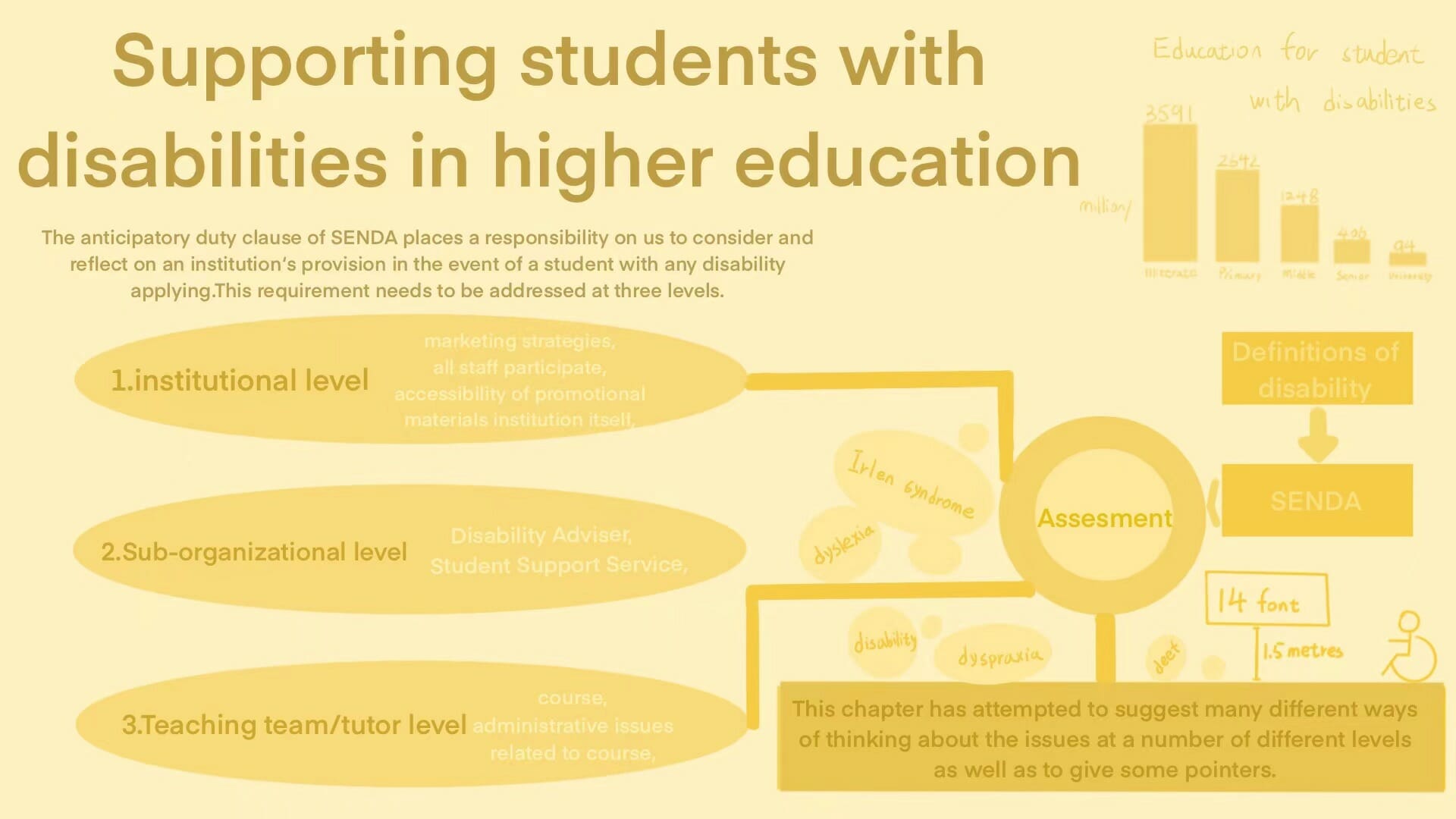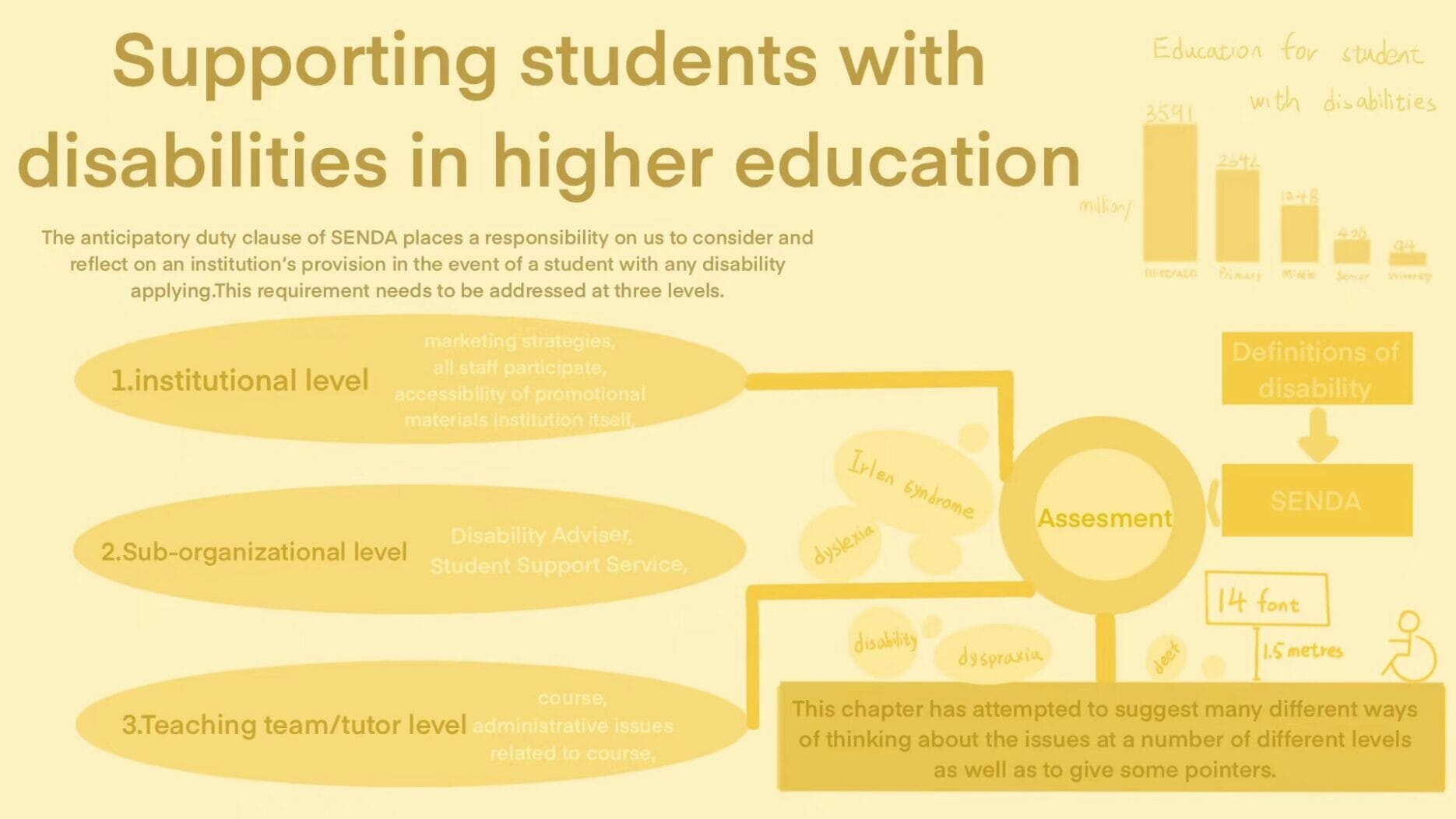支持残疾学生参与高等教育
The chapter is intended that the issues raised will also prompt reflection on existing practice. After a discussion of the definition of disability, and some of the background, there follows a discussion of implications and issues of the Special Educational Needs and Disability Act (SENDA) of 2001 at the institution, departmental and individual tutor level. Throughout, reference is made to the national Professional Standards Framework, so readers can locate their own practice in conjunction with both these reference points. At various points in the chapter there are discussion points to help readers reflect on the provision in their own institutions. Finally, some case studies are intended to act as a stimulus for further reflection.
本章的目的是,所提出的问题将促使人们对现有实践进行反思。在讨论了残疾的定义和一些背景之后,接着讨论了2001年《特殊教育需要和残疾法》(SENDA)在机构、部门和个人导师层面的影响和问题。在整个过程中,参考了国家专业标准框架,因此读者可以结合这两个参考点来定位自己的实践。在本章的不同点上,有一些讨论点,帮助读者反思他们自己机构中的规定。最后,一些案例研究旨在刺激读者进一步思考。
导读目录
- Some common definitions of disability 一些残疾常见的定义
- Background 背景
- lnstitutional 机构
- Sub-organisational 次级组织
- Individual tutor 私人导师
- Example 例子
- Reflect 反思
1. Some common definitions of disability 一些残疾常见的定义
Section 1 of the Disability Discrimination Act 1995 states that a person has a disability if he or she has a physical or mental impairment which has a substantial and long-term adverse effect on their ability to carry out normal day-to-day activities.
In 2001 SENDA amended the 1995 Act, drawing in education, which had previously been exempt. Since then the Disability Rights Commission (2006a) has requested a review of the definition of disability to focus less on the medical state of the person but rather on the impact of any unfair, or unjustified, treatment, and any disadvantage resulting from such treatment.
1995年《残疾人歧视法》第1条规定,如果一个人的身体或精神损伤对其进行正常的日常活动的能力有重大和长期的不利影响,他或她就有残疾。
2001年,SENDA对1995年的法案进行了修订,在教育方面进行了借鉴,以前是豁免的。此后,残疾人权利委员会(2006a)要求对残疾的定义进行审查,以减少对个人医疗状况的关注,而是关注任何不公平或不合理的待遇的影响,以及这种待遇带来的任何不利因素。
2. Background 背景
Students with disabilities are entering higher education in ever greater numbers and have a right to demonstrate their capabilities as much as other students. It is the responsibility of those who work in universities to make sure that students’ disabilities do not prevent them from gaining that access to learning.Many students are already mature students because they are adult and they have found their own methods over the years which support them in managing their disability.The sheer diversity of disabilities that are now commonly encountered in higher education means that there has to be a significant reordering of priorities for university teachers.Consider the variety of disabilities, and how these are increasing daily as more is learnt about disability, this is not an easy challenge to meet. This requirement needs to be addressed at three levels.
1. Institutional level.
2. Sub-organisational level, e.g. faculty.
3. Teaching team/tutor level.
越来越多残疾学生进入高等教育,他们与其他学生一样,都有展示自己能力的权利。大学工作者有责任保障学生的残疾不会妨碍他们获得这种学习机会。许多学生已经是成熟的学生,因为他们是成年人,多年来他们已经找到了自己的方法,支持他们管理自己的残疾。现在在高等教育中经常遇到的残疾的多样性意味着必须对大学教师的优先事项进行重大的重新排序。考虑到残疾的种类,以及随着对残疾进一步了解,每天都在增加。这不是一个容易应对的挑战。这一要求需要在三个层面加以解决。
- 机构层次
- 次级组织层面,如院系
- 教师团队/导师层次
lnstitutional 机构
How an institution markets itself, the location of marketing strategies and the accessibility of promotional materials are of crucial importance in the first instance in demonstrating an institutional commitment to inclusion.You can reflect on the following issues
- Are you only using traditional forms of marketing or are you making use of internet sites and other resources?
- Do all essays need to conform to a format or can the information be presented in a variety of formats equally well?
- Is signage on campus suitable for students with visual difficulties and at a good level for wheelchair users
- Is there a designated area/policy for the use of guide dogs?
All staff involved in recruitment days need to be aware of the answers to these questions, not just a few ‘specialists’, as this reflects the awareness and importance attached to such issues. If someone does not know the answers, it may suggest to the potential student that this is a low-priority area.
一个机构如何推销自己、营销战略的位置以及宣传材料的可访问性,首先要表明机构对包容性的承诺至关重要。可以从以下的问题反思。
- 你是只使用传统的营销形式还是利用互联网网站和其他资源?
- 所有的论文都需要符合一种格式,还是可以用各种格式同样地呈现信息?
- 校园内的标牌是否适合有视觉障碍的学生,并为轮椅使用者提供良好的水平。
- 是否有指定区域/政策供导盲犬使用?
所有参与招聘日的工作人员都需要了解这些问题的答案,而不仅仅是几个 “专家”,因为这反映了对这些问题的认识和重视。如果有人不知道答案,这可能会向潜在的学生暗示这是一个不重要的方式。
Sub-organisational 次级组织
In many HEIs, all students declaring a disability on application are invited to an interview with the university student support service (SSS) prior to acceptance onto a course. This service is university wide and provided across all departments. The SSS plays a strategic role for all students with disabilities by undertaking risk assessments of teaching areas, ensuring disability compliance on field trips.
For example, at Liverpool Hope, a named Disability Adviser (DA) in each department. This person forms a point of contact once students are accepted on a course and all students are advised to make contact with their DA early on.Training and Development Agency (TDA) conference suggested.Disability Adviser is arguably integral to the support network and the efficient management of teaching and learning. The DA can provide a point of reference between the SSS.If there is no DA in post, these responsibilities could fall to individual tutors, which could then create a diversity of support across the organisation both positively and negatively.The DA’s personal skills and knowledge need to be constantly updated in order for such a system to work effectively within an institution. Experienced Disability Advisers should know all the students within their remit who have learning support plans and often social monitoring can be undertaken informally between the SSS and the DA.
在许多高等教育机构中,所有在申请时申报残疾的学生在被录取到课程之前都会被邀请参加大学学生支持服务(SSS)的面试。这项服务是全校性的,并在所有院系提供。SSS为所有残疾学生发挥战略作用,对教学区进行风险评估,确保实地考察符合残疾标准。
例如在利物浦霍普大学,每个系的指定残疾顾问(DA)。一旦学生被课程录取,这个人就会形成一个联络点,建议所有学生尽早与他们的DA联系。培训和发展机构(TDA)反馈,残疾顾问是支持网络和有效管理教学的组成部分。DA可以在SSS和学术导师之间提供一个参考点。如果没有DA,这些责任可能会落在个别辅导员身上,这可能会在整个组织中产生积极和消极的多样性。DA的个人技能和知识需要不断地更新,为了能在这样一个机构内有效地工作。有经验的残疾顾问应该知道他们职权范围内所有有学习支持计划的学生,通常社会监督可以在SSS和DA之间非正式地进行。
Individual tutor 私人导师
In the case of individual tutors, we think primarily about administrative issues within the classroom and administrative issues related to courses.
- Access to and set-up of a room – to ensure access for students with mobility difficulties and the use of a horseshoe shape to facilitate discussion activities with deaf or visually impaired students.
- Assessment strategies both on course and as final assessment: does a course or module include a range of forms of assessment and choice?
- Whether the font size setting position is suitable for visually impaired people to view?
- Tutor support for those who require particular assistance such as glossaries, proofreading and feedback on drafts. DfES (2006) details how even the most wellprepared and self-sufficient students can feel ‘deskilled in the face of unfamiliar and varying academic practices’.
A personal recommendation is that all notices are printed in bold font 14 for all students and placed no more than 1.5 metres from the ground. Front 14 being suitable for the needs of dyslexic students, while the height should be suitable for a wheelchair user. In addition to this, many students have the requirement to have notices emailed to them by the support staff for that course.
就私人导师而言,我们主要思考课堂内和与课程有关的行政问题。
- 进入和布置房间–确保行动不便的学生能够进入,并使用马蹄形来促进聋哑或视力受损学生进行讨论活动。
- 课程中和期末评估的评估策略:课程或模块是否包括一系列的评估形式和选择?
- 字体大小设置位置是否适合视障人士查看?
- 导师对那些需要特别帮助的人的支持,如词汇表、校对和对草稿的反馈。DfES(2006)详细介绍了即使是准备最充分、最自立的学生也会感到 “在面对不熟悉的和不同的学术实践时被淘汰”。
笔者提出了部分建议,例如所有的通知都要用14号黑体字印刷,供所有学生使用,并放在离地面不超过1.5米的地方。14号字体适合有阅读障碍的学生的需要,而高度应该适合轮椅使用者的需要。除此以外,许多学生都要求该课程的支持人员通过电子邮件向他们发送通知。
3.Example 案例
Good practice for disabled students means providing them with a high-quality learning experience. Resources invested in such practices should not be viewed as limited for the use of disabled students but should be regarded as an investment to benefit all students. The following are some practical suggestions which readers might like to consider in their own practice.
a. Looped systems need checking to ensure that the systems are working, and that all equipment has fresh batteries. The only way to do this is with a student who uses the looped system, so it is often helpful to ask a student using these facilities to arrive early so that you can check they are all working. If the student is happy to rely on other methods if the system doesn’t work, then there isn’t a problem but you do need to demonstrate that you have taken every effort to support his/her needs.
b. Each group may need special consideration when teaching, as so much is conveyed through facial expression. Lip-reading students need to be able to see the tutor’s face clearly with good lighting on the face. This is very difficult if tutors have a habit of walking around while talking or turning their back to point to visual displays. A well thought-out delivery helps students keep track of what is being said. Interjections and asides are not very helpful for deaf students who may be struggling with keeping up with the focus of the lecture, nor to autistic spectrum disorder students. Tutors need an understanding of the difficulties of hearing-impaired students and to adjust their method of delivery as needed. This can be achieved easily through activities in training, which can be undertaken either in-house or by requesting an input on deaf awareness from your local centre for deaf people. Sometimes it is helpful to have a friendly observer sit in to note ‘bad habits’ and point them out, as usually we do not know our own habits and students are often too polite to enlighten us.
对残疾学生的良好做法意味着为他们提供高质量的学习体验。投入到这种实践中的资源不应被视为仅限于残疾学生使用,而应该被视为惠及所有学生的一种投资。以下是一些实用的建议,读者可以在自己的实践中加以考虑。
a. 循环系统需要检查,以确保系统工作,并且所有设备都有新鲜电池。做到这一点的唯一方法是与使用循环系统的学生一起,所以要求使用这些设施的学生提前到达,以便能检查它们是否都在工作,这通常是有帮助的。如果学生乐意在系统不工作的情况下依靠其他方法,那么就没有问题,但你需要证明你已经尽了一切努力支持他/她的需求。
b. 每个群体在教学时都可能需要特别考虑,因为很多事情都是通过面部表情传达的。读唇语的学生需要能够清楚地看到导师的脸,并在脸上有良好的照明。如果导师有在说话时走来走去的习惯或转过身去指着视觉显示器就会变得非常困难。经过深思熟虑的授课方式有助于学生掌握所讲的内容。插话和旁白对聋哑学生帮助不大,因为他们可能很难跟上讲座的重点,对自闭症谱系障碍学生也是如此。辅导员需要了解听障学生的困难,并根据需要调整他们的授课方法。这可以通过培训中的活动轻松实现,培训可以在内部进行,也可以向当地的聋人中心申请关于聋人的事情。有时,让一个友好的观察者坐在一旁注意 “坏习惯”并指出它们,是很有帮助的,因为通常我们不知道自己的习惯,而学生们也常常有礼貌地指点我们。
4.Reflect 反思
It is important always to be aware of the limitations, as well as the opportunities, of what is being offered and of any alternatives. In all cases, fitness for purpose should be evaluated. The onus should be on the provider offering a suitable adjustment, rather than waiting until the student encounters a difficulty and requests it. Reflective practice means thinking carefully about how best to ensure that disabled students receive a comparably high-quality learning experience as enjoyed by their non-disabled peers. This chapter has attempted to suggest many different ways of thinking about the issues at a number of different levels as well as to give some pointers.
重要的是,要始终意识到所提供的东西的局限性和机会,以及所有替代方案。在所有情况下,都应评估是否符合目的。提供者应承担适当调整的责任,而不是等到学生遇到困难时才提出要求。反思性实践意味着要仔细思考如何最好地确保残疾学生获得与非残疾学生一样的高质量学习体验。本章试图提出许多不同层次的思考问题的方法,并给出一些指导意见。
信息可视化图(infographic)

Comments
很有趣的一段经历,第一次一个人啃下一篇英语论文,在网站上发表自己的感想。对于我这个英语白痴来说是段很难忘的经历了哈哈哈。很感谢老师慷慨的教导~真的学到了很多东西,不仅仅是阅读理解论文,还扩宽了我的视野。感觉老师就像哆啦A梦一样啥都会,是个很大的启发,让我意识到我也不应该仅满足于此,多学多看多走。
预祝大家新年快乐~
原文
Campbell, A., & Norton, L. (Eds.). (2007). Learning, teaching and assessing in higher education: Developing reflective practice. Learning Matters. 130-139.

发表回复